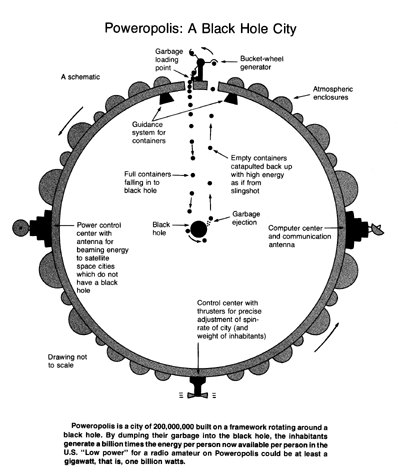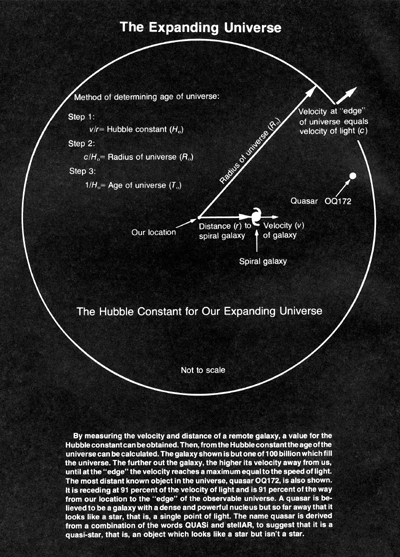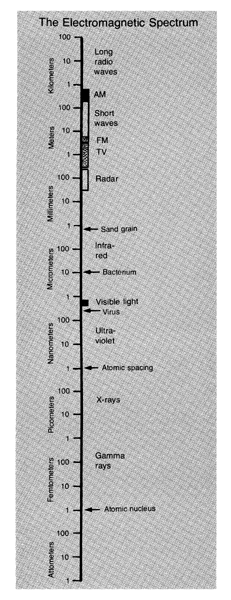|
ABCs of Space
By: John Kraus
A. How Do You Harness a Black Hole?
Nowadays universities have astronomy departments, aeronautical engineering departments and even astronautical engineering departments. As yet, however, I am not aware of any astro-engineering departments. But some day there may be and what kind of courses might be offered? Probably ones on the mining of asteroids, construction of space habitats and even possibly one on "Harnessing of Black Holes."
A first consideration regarding the last item would be data on critical distances and strategies on how to approach a black hole without falling in. A second consideration would be a discussion of how a black hole is a potential source of great amounts of energy if you go at it right. And finally, the instructor would probably get down to the details of the astroengineering required with blueprints of a design and calculations of the expected power generating capability.
This may sound a bit futuristic and it is, but the famous text "Gravitation" by Charles Misner, Kip Thorne and John Wheeler includes a hypothetical example about how an advanced civilization could construct a rigid platform around a black hole and build a city on the platform.
 The discussion goes on to say that every day garbage trucks carry a million tons of garbage collected from all over the city to a dump point where the garbage goes into special containers which are then dropped one after the other down toward the black hole at the center of the city. The container is dragged by the black hole's strong gravity into a vortice-like whirlpool swirling around the black hole, spiralling inward toward the critical distance. When the container reaches a certain "ejection point" it dumps its load and as the garbage goes on into the hole the empty container recoils and is catapulted back up where it is caught by a giant bucket-studded flywheel. The container's energy spins the flywheel and this in turn runs a generator. With a succession of garbage containers falling in and flying back up, the generator provides a steady power supply for the city.
The discussion goes on to say that every day garbage trucks carry a million tons of garbage collected from all over the city to a dump point where the garbage goes into special containers which are then dropped one after the other down toward the black hole at the center of the city. The container is dragged by the black hole's strong gravity into a vortice-like whirlpool swirling around the black hole, spiralling inward toward the critical distance. When the container reaches a certain "ejection point" it dumps its load and as the garbage goes on into the hole the empty container recoils and is catapulted back up where it is caught by a giant bucket-studded flywheel. The container's energy spins the flywheel and this in turn runs a generator. With a succession of garbage containers falling in and flying back up, the generator provides a steady power supply for the city.
To quote from Misner, Thorne and Wheeler,
"Not only can the inhabitants of the city use the black hole to convert the entire rest mass of their garbage into the kinetic energy of the vehicle (or container) and hence into electrical power but they can also convert some of the mass of the black hole into electrical power!"
Now a million tons (mass) of garbage a day converted into energy in this way would produce more than a billion trillion watts of power or nearly a billion times the present-day power production of the entire world.
Whereas Rube Goldberg's schemes were usually plausible but impossible, this black hole scheme seems both plausible and possible (theoretically). Many details would need to be worked out, but who knows, it may already be used by an advanced civilization somewhere in the universe.
Summary:
- A black hole can provide the ultimate in trash disposal and also huge amounts of energy.
- Although we do not yet offer courses on the details, a black hole city with power generating system may already be in existence somewhere in the universe.
B. Is the Universe 10 or 20 Billion Years Old?
Using radio and infra-red techniques, a team of astronomers has been in the news lately with results implying a universe 10 billion years old. This is half the value currently used by many other astronomers. While the news announcement has caused quite a stir in astronomical circles its effect on Wall Street was imperceptible.
The team in the news consists of Marc Aaronson (Steward Observatory, University of Arizona), Jeremy Mould (Kitt Peak National Observatory, Tuscon, Arizona), John Huchra (Harvard/Smithsonian Center for Astrophysics), and Woodruff Sullivan III, Robert Schommer and Gregory Bothun (University of Washington).
How old is the universe? It is so old and big that this is very difficult to determine. Assuming the universe has expanded uniformly since the Big Bang, its age increases with its size. If we know how big it is, then we know how old it is. The ratio of the radius of the universe to the velocity of light is a number whose reciprocal is called the "Hubble constant", after Dr. Edwin P. Hubble (1889-1953), the father of the expanding universe idea. Put another way, the reciprocal of the Hubble constant equals the age of the universe. Thus, the smaller the Hubble constant, the older the universe.
In my text-book "Radio Astronomy" (McGraw-Hill) published in 1966, I state:
"The correct value for the Hubble constant is uncertain. A nominal value in wide present-day (circa 1965) usage is 100 kilometers per second per megaparsec. Values between 180 and 75 have been used during the past decade (corresponding to ages of about 5 to 13 billion years)."
Using the 100 kilometer value yields an age for the universe of about 10 billion years.
In the years after my book was published, astronomers reported lower and lower values of the Hubble constant until recently it was thought to be only half as large implying a universe 20 billion years old. Now come Aaronson and his team with a Hubble constant of almost 100 putting us back again to 10 billion years.
In the premier issue of COSMIC SEARCH (January 1979) we adopted 15 billion years as a nominal value for the age of the universe (and 15 billion light-years for its radius) in the COSMIC CALENDAR and DISTANCE TABLE. It is interesting that this value is the average of the extremes of 10 and 20 billion years currently under discussion. [Note. Although not printed in this issue of the magazine, the COSMIC CALENDAR and the DISTANCE TABLE are reproduced at the end of this webpage.]
The apparent uncertainty in the Hubble constant is not surprising since the great distances involved cannot be measured directly but must be estimated by indirect, roundabout methods which may be ambiguous. Astronomers are simply groping and working their way toward a more certain value.
The pioneering step that made the new radio and infra-red measurements possible was taken in 1975 at the National Radio Astronomy Observatory (NRAO), Green Bank, West Virginia, by Brent Tully (University of Hawaii) and Richard Fisher (NRAO). They noted a correlation between the brightness of a spiral galaxy and the broadening of its 21 centimeter hydrogen line radiation. The more massive a galaxy, the faster it rotates and the broader the line due to the Doppler shift of radiation from
parts approaching (wavelength shorter) and from the parts receding (wavelength longer). Thus, from the broadness of the line the mass of the galaxy could be estimated. The more massive the galaxy the more light it should emit. So, if a galaxy which appears faint is deduced from its hydrogen line width to be massive, it must be far away. Refining this method, Aaronson, Mould and Huchra, used infra-red radiation instead of light to gauge the brightness, and measured the distance of much more remote galaxies than previously possible. Astronomers quoting a smaller Hubble constant have used optical methods on much nearer galaxies. Aaronson and his team do not believe that what is going on nearby is necessarily representative of the large scale cosmic motions farther out.
 The velocity of recession of a distant galaxy (as determined from its redshift) divided by its distance gives a value for the Hubble constant. If further and further galaxies could be measured the velocity would approach the velocity of light and the distance the radius of the observable universe but, for uniform expansion, the ratio, or Hubble constant, should remain the same, that is, be what its name implies: a constant.
The velocity of recession of a distant galaxy (as determined from its redshift) divided by its distance gives a value for the Hubble constant. If further and further galaxies could be measured the velocity would approach the velocity of light and the distance the radius of the observable universe but, for uniform expansion, the ratio, or Hubble constant, should remain the same, that is, be what its name implies: a constant.
Will astronomers agree on 10 billion years or will it be 20? The controversy may go on for years. In the meantime we will continue to use 15 (plus or minus 5) in the COSMIC CALENDAR.
The significance of the age of the universe is that if the universe is young we may be the only example of intelligent life but if it is old there may have been time for life to evolve in many places and we may be "e pluribus unum" or "one of many" examples.
AGE OF THE UNIVERSE TABLE
(Small Hubble, old universe; big Hubble, young universe)
Hubble
constant
(in hubbles*) |
Radius of
universe
(in billions of
light-years) |
Age of
universe
(in billions
of years) |
|---|
50
67
100 |
20
15
10 |
20
15
10 |
|
*"One hubble equals one kilometer per second per megaparsec where one megaparsec equals 3.26 million light-years. The table values for the radius and age of the universe are nominal round-offs.
The radius R0 of the universe equals the velocity of light c divided by the Hubble constant H0, (R0 = c/H0). The age of the universe in years is numerically equal to the radius of the universe in light-years. A convenient relation is that the age of the universe T0 in billions of years is approximately equal to 1000 divided by the Hubble constant in hubbles (or T0 = 1000)/H0). (If we use a more accurate value of 978 instead of 1000 and Aaronson's stated value of 95 hubbles, we get an age of 10.3 (= 978/95) billion years).
A Hubble constant of 100 hubbles implies that a 10 meter radial length stretches 1 millimeter longer in one million years. Thus, we may express 100 hubbles as 1 millimeter per million years per 10 meters.
HUBBLE TROUBLE
Hubble bubble toil and trouble,
The cosmos ages 'til it's double.
Most distant quasar one-seven-two*,
How old, how far away are you?
Ten billions of years or twenty?
Let's say fifteen is aplenty,
And spare our good Dr. Hubble
From further change and trouble.
*Refers to the quasar radio source OQ172 with the greatest known redshift (3.54) and inferred distance close to the observable limit (or "edge") of the universe.
C. Waves of All Kinds
There are water waves, sound waves, heat waves and many more kinds of waves. Although they may differ in certain respects, they all have one thing in common: They move or travel with a characteristic velocity. Sound waves travel in air 1000 feet per second while radio waves can travel around the earth seven times in a second.
We can divide waves in general into two groups: (1) those that travel only through solids, liquids and gases, and (2) those that can travel through vacuum (or empty space).
The first group we might describe as mechanical waves, including:
Water waves, visible on the surface of lakes or oceans,
Seismic waves, or vibrations transmitted through the ground from earthquakes,
Sound waves, by which we hear,
Waves on strings or wires, as in musical instruments.
 The second group embraces the electromagnetic waves, including:
The second group embraces the electromagnetic waves, including:
Radio waves, which carry AM, FM, TV, radar and all kinds of communications,
Infra-red waves, or heat waves, which warm our bodies,
Light waves, by which we see,
Ultra-violet waves, which can sterilize and tan,
X-rays or waves, which doctors and dentists use to see through your body,
Gamma-rays or waves, which are emitted by some uranium products and in vast amounts by nuclear explosions.
All of these waves are fundamentally similar, involving the propagation of electric and magnetic effects at a speed, in air or vacuum, of 300,000 kilometers per second. They differ only in wavelength from the radio waves at the long wavelength end to gamma waves at the short wavelength end. The range in wavelength is enormous. Radio waves may be many kilometers in length while gamma rays, on the other hand, are so short that it takes a billion of them to stretch across the dot or period at the end of this sentence. The relationship of these waves is presented by The Electromagnetic Spectrum, with scales of wavelength in meters.
Caption for the graphic "The Electromagnetic Spectrum":
The electromagnetic spectrum or wavelength scale from the shortest gamma rays to the longest
radio waves. The wavelengths for AM, FM and TV broadcasting, for radar and for visible light are indicated. The size of objects including a sandgrain, a bacterium, a virus, the spacing of atoms and an atomic nucleus are shown for comparison.
Thus far we have neglected mention of another kind of wave which is believed to travel through empty space at the same speed as electromagnetic waves, yet it isn't an electromagnetic wave. This is the gravity wave discussed in ABCs of Space in the last issue of COSMIC SEARCH.
These waves are presumably radiated by rotating double star systems and during catastrophic events such as a stellar collapse into a pulsar or black hole. If the rotating star system made one revolution per week the wavelength would be gigantic: one-half light-week. The distance to the moon is only one light-second and the distance to Pluto only a few light-hours so the gravity wavelength from the stars would be seven times the diameter of our solar system (at the orbit of Pluto). Some day we may be able to detect such waves.
Summary:
- A sound wave can travel through air but not through vacuum.
- Radio waves and light waves can travel through vacuum.
- Radio waves and light waves are electromagnetic waves.
- Gravity waves are believed to travel as fast as electromagnetic waves but are not electromagnetic.
COSMIC CALENDAR
| 15 billion BC | Universe began (BIG BANG) |
| 10 billion BC | Our galaxy formed |
| 5 billion BC | Solar system (sun, earth and other planets) formed |
| 2 million BC | Homo sapiens emerged |
| 5000 BC | Writing invented |
| 1888 AD | Hertz produced radio waves |
| 1903 AD | Letter "S" sent by radio waves across Atlantic Ocean by Marconi |
| 1959 AD | Cocconi and Morrison proposed SETI |
| 1960 AD | First attempt to detect extraterrestrial civilizations by Drake |
| 1979 AD | First issue of COSMIC SEARCH |
DISTANCE TABLE
Distances in light travel time (approx.)
| Earth to moon | 1 second |
| Earth to sun | 500 seconds (8 min.) |
| Sun to Mars | 12.5 minutes |
| Sun to Jupiter | 40 minutes |
| Sun to Pluto | 5.5 hours |
| Solar system diameter (at orbit of Pluto) | 11 hours |
| Sun to nearest star | 4 years |
| Sun to center of galaxy | 30,000 years |
| Diameter of galaxy | 100,000 years |
| Distance of Andromeda galaxy | 2 million years |
| Distance to "edge" of universe | 15 billion years |
To convert light travel time to kilometers multiply travel time in seconds by velocity of light (300,000 kilometers per second).
|
![[NAAPO Logo]](../../Images/NAAPOsm.jpg)
![[NAAPO Logo]](../../Images/NAAPOsm.jpg)